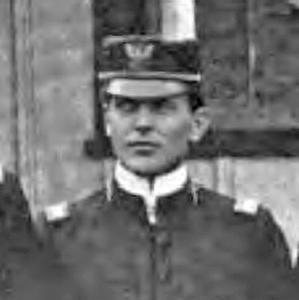

Campbell Wallace Flake
Company A 22nd Infantry
KIA 01/22/1904
Campbell W. Flake was born in
Greene County, Georgia on October 31, 1875.
He graduated from Young Harris College in Georgia in 1895.
Flake enlisted as a Private in
the 3rd U.S. Volunteer Infantry on June 21, 1898. He was mustered
out of the
3rd U.S.V.I. on May 2, 1899 after having served with the Regiment
on occupation duty in Cuba. During his
service with the 3rd U.S.V.I. he had attained the rank of 1st
Sergeant of Company I.
On February 2, 1901 he was
offered a commission as a 2nd Lieutenant in the 27th Infantry,
accepting the position on July 26 of that year. He was assigned
to Company A at Fort McPherson,
Georgia on September 1, 1901. He was transferred to Company D on
November 20, 1901.
Flake was transferred to the
22nd Infantry on December 2, 1901. He was assigned to Company A
at
Fort McPherson, Georgia on January 16, 1902. He served with
Company A at Fort Reno, Indian Territory
and at Fort Riley, Kansas. From July 27 to September 25, 1903 he
was on a leave of absence.
In October 1903 Flake sailed
with the 22nd Infantry aboard the transport Sheridan for
the Philippines.
At Camp Marahui on the island of Mindanao with Company A's
Commander Captain Joseph Donovan
temporarily assigned to command 3rd Battalion and Company A's 1st
Lieutenant William Neely temporarily
assigned to command Company C, Flake assumed command of Company A
on December 23, 1903.
Still in command of Company A
2nd Lieutenant Campbell W. Flake was killed in action on
Mindanao,
Philippine Islands, on January 22, 1904.
While on an expedition leading
Company A as part of 1st Battalion, Flake and his fellow officer,
2nd Lieutenant William E. Roberts,
the 1st Battalion Quartermaster, were with the lead elements of
the Battalion, when they came upon a Moro fort, or cotta,
at the entrance to the village of Ramaien, at the northern end of
Lake Lanao.
Attempts were made to parley
with the inhabitants of the fort, who responded as if to desire
such a
parley, but armed warriors in and around the fort carried out
activities which suggested they were
preparing for battle, not for talking.
Before the Moros could assume
strong defensive positions, Flake and Roberts led a charge
against the fort,
and both were cut down by a hail of bullets from the fort.
Flake's men were forced to withdraw under the deadly fire,
dragging their wounded officers to safety. Lieutenant Roberts was
severely wounded when struck in the right shoulder
from the gunfire. Private Charles Foy also from Company A was
lightly wounded by a bullet
which glanced off his head above his right eye.
Lieutenant Flake suffered
gunshot wounds through his left shoulder and his abdomen.
Flake's wounds proved to be fatal.
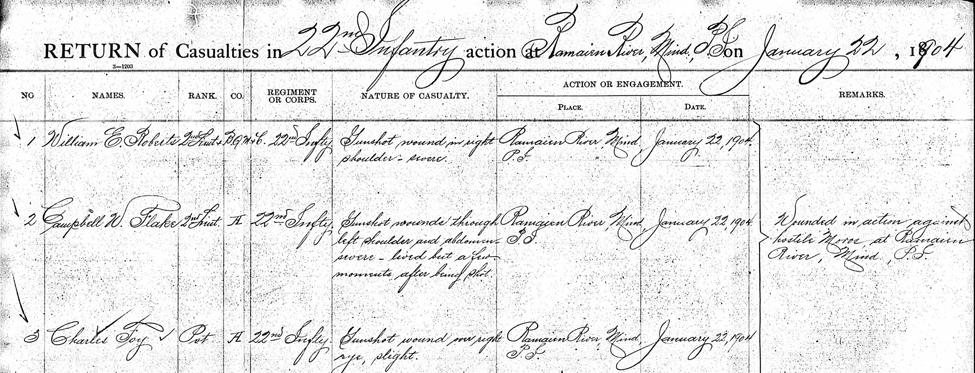
The Return of Casualties for the 22nd Infantry January 22, 1904.
On Line 2 Campbell W. Flake is noted as receiving:
"Gunshot wounds
through
left shoulder and abdomen -
severe - lived but a few
moments after being shot."
The Regimental history from 1904 provides a short biography of Campbell Flake:
GENERAL ORDERS No. 1,
HEADQUARTERS 22ND U.S. INFANTRY.
CAMP MARAHUI, MINDANAO, P. I. January 23rd, 1904.
It has become the sad duty
of the Regimental Commander to announce the death of an officer:
2nd Lieutenant Campbell W. Flake, 22nd infantry.
Killed in action at Ramaien river, Lake Lanao, Mindanao January
22, 1904, against savage and treacherous Moros.
He died a soldier's death. Shot dead on the field of battle.
His record is closed. He has given his life to his country.
Brave, courteous, prompt,
willing, and efficient were the qualities which endeared him to
all.
The regiment has lost a fine young officer, cut down in the prime
of his splendid physical strength. His loss is deeply mourned.
To the widow and orphan sincerest sympathy is extended.
Lieut. Flake was born October 31, 1875. Enlisted June 17, 1898,
in the 3rd U. S. vol. infantry, and served as first sergeant
until May 2, 1899, when he was mustered out. During this time he
served in Cuba from August, 1898, until April, 1899.
Commissioned 2nd lieutenant of infantry on July 15, 1901, and
assigned to 27th infantry.
Transferred to 22nd infantry, December 2, 1901, and assigned to
company A, in which organization he served until killed.
As a mark of respect officers of the regiment will wear the usual
badge of mourning for thirty days.
BY ORDER OF COLONEL WYGANT:
R. L. HAMILTON,
Captain, 22nd Infantry Adjutant.
|
Newspapers in the United
States reported the death Left: The Washington Times Saturday January 23, 1904 |
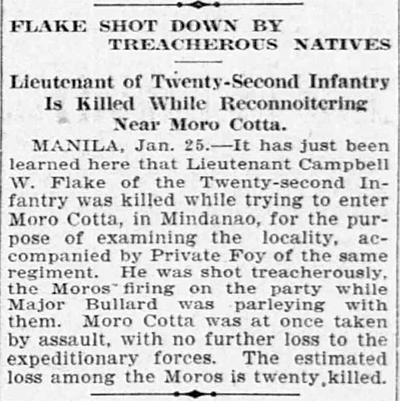
Newspaper clipping
announcing the death of Campbell Flake.
Printed in the San Francisco Call,
Tuesday, January 26, 1904
CDNC California Digital Newspaper Collection
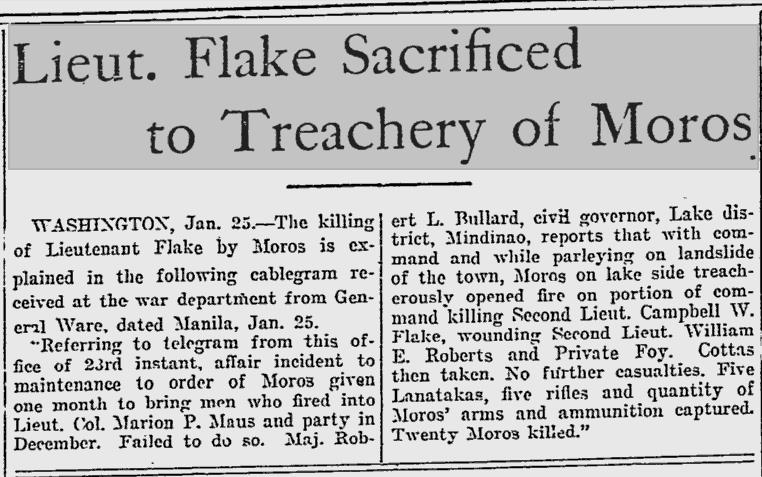
Newspaper article on Flake's death from the New London newspaper The Day January 1904
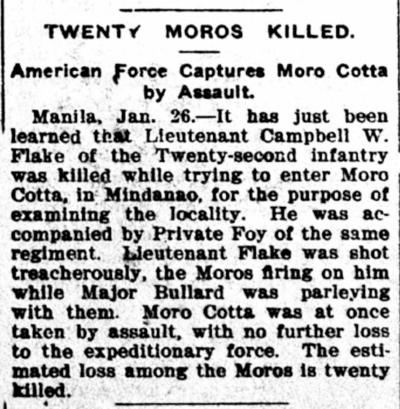
Bismarck Daily Tribune Tuesday January 26, 1904
Library of Congress Chronicling America website
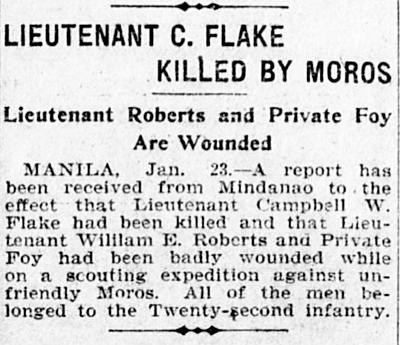
Los Angeles Herald Sunday January 24, 1904
CDNC California Digital Newspaper Collection
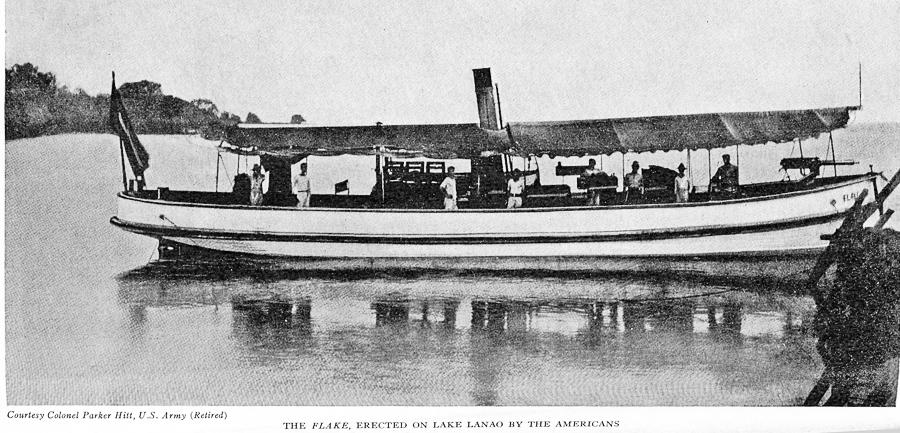
The gunboat Flake on Lake Lanao, Island of Midanao, Philippine Islands.
Named after Lt. Campbell
Flake, the gunboat was used in several actions by the 22nd
Infantry on Mindanao,
in 1904 and 1905. It mounted a 37mm Vickers/Maxim automatic rapid
fire gun on the bow.
From Amphibious
Infantry A Fleet On Lake Lanao by Colonel Parker
Hitt,
US Naval Institute Proceedings 1938

Campbell Flake's decorations
Left to right: Spanish War Service Medal, Cuban Occupation Medal,
Philippine Campaign Medal
Macon Telegraph - 9/29/1904 -
Page 6.
LIEUT. FLAKE'S REMAINS
DEKALB COUNTY BOY WAS KILLED IN THE PHILLIPPINE ISLANDS
Atlanta, September 23 - the remains of Lieut. Campbell W. Flake
of the Twenty-second United States infantry reached Atlanta
today from San Francisco. The funeral services will be held
Sunday next at Trinity Methodist Church. The boy will be buried
with military honors. The Sixteenth infantry, commanded by Col.
Price, and the regimental band of the post will escort
the remains to Oakland Cemetery, where the interment will take
place.
Lieut. Flake was a DeKalb county boy who enlisted in the army at
the beginning of the Spanish-American way,
and by his good work was soon promoted to a lieutenancy. He was
killed a few months ago in the Phillipines
while bravely fighting at the head of his company.
From the Find A Grave website
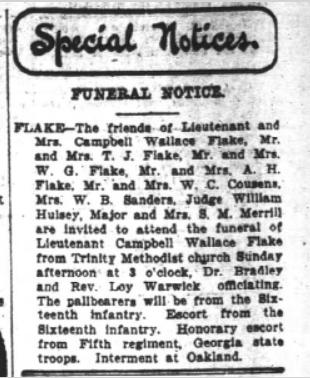
Funeral notice for Campbell Flake
The pallbeareers and
escort were from the 16th US Infantry Regiment
stationed at Fort McPherson, Georgia.
Photo by Judy K. Brantley/Wilson from the Find A Grave website
|
Left: Campbell W. Flake From The Atlanta
Constitution |
MILITARY HONOR MARKS FUNERAL
Lieutenant Flake Is Laid to Rest in
Oakland.
Details from Sixteenth United States and Fifth Georgia Accompany
Remains to Last Resting Place
-- Brave Officer Was Killed in Philippines.
With all of the solemn pageantry of a military funeral, services
were held over the remains of Lieutenant Campbell Wallace Flake
at Trinity Methodist church yesterday afternoon. Lieutenant Flake
was a member of the Twenty-second United States Infantry,
Company A, and was shot to death while leading his men against a
fortified Moro House at Ramien, Lake Lanao, in the Philippines.
There were details from the Sixteenth, now stationed at Fort
McPherson, and members of the Fifth regiment of Georgia,
under Colonel Anderson, the regulars in their uniforms of khaki
and the state troops in their uniforms of blue.
From the undertaking parlors of Barclay Brandon, the ashes of the
deceased were escorted by a platoon of soldiers, the remains
being carried on a caisson draped with the American Stars and
Stripes under which Lieutenant Flake fell fighting, while resting
on the casket were the belt and sword and the cap worn by the
officer. As the remains neared the church the band of the
Sixteenth
played "Nearer My God to Thee" and the casket was
carried into Trinity church which was already crowded with many
standing.
The detail for the funeral from Fort McPherson was composed of
one platoon Co. E 16th Infantry with necessary complement of
non-commissioned officers and one musician, under command of 2nd
Lieutenant Louis Soleiac.
The following named officers acted as pall bearers: Second
Lieutenants Kingman, Hyatt, Churchlll, James, McCune, Peyton,
Atkins and Pickering. The following named sergeants, 16th
Infantry, acted as body bearers: Sergeant Barton Company A;
Sergeant Edward P. Moore, Company B; Sergeant Girard A. Gamanche,
Company C; Sergeant Angus McDonald,
Company D; Sergeant Edward Mahoney, Company E; Sergeant William
F. Fender, Company F; Sergeant Hans P. Johnson,
Company G; Sergeant Alexander White, Company H. Service by Dr.
Bradley.
Rev. Dr. H. S. Bradley, pastor
of the Trinity Methodist church, conducted the services.
Explaining that he had known the
young officer but slightly before he had left Atlanta to go to
the Philippines, he took occasion to dwell on the subject of
death,
the death that is only sleeping and leads to eternal life, rather
than any eulogy of Lieutenant Flake. This officer had considered
his duty more than his life, and had met death In the carrying
out of commands from his superior officer. There was simply
no greater eulogy than this simple fact which spoke so much more
eloquently than words. There was the singing of
"One Sweetly Solemn Thought" and other hymns that carry
with them the comfort that means so much to this hour of trial.
Then Dr. Bradly spoke of the real time of rejoicing in the
highest sense attending death, rather than the customs which are
so universal in this present time. He pointed out many places in
the Scriptures and in every instances emphasised the fact that
death was always referred to as the beginning of better things
with the rest that comes after a life of struggling and trying.
- With the close of the service the remains were again carried.
There was the slow tolling of the bell and then the column,
headed by the
Band under Chief Musician Kline, led the way to Oakland cemetery.
There was the long roll of the muffled drums that seemed to catch
the sad
note of the tolling bell, the music of horns hushed to the
softness of sorrow and the measured tread that with the
"Dirge Dolorosa" started
on the last march of the brave young Atlanta officer. At the
cemetery there was the last salute and above the floral offerings
curled the
smoke of the rifles as a fitting benediction for a young soldier
who died nobly for love of country.
The Atlanta Constitution Monday October 3, 1904
Burial:
Oakland Cemetery
Atlanta
Fulton County
Georgia
Section 7, Block 340, Grave 2
|
Left: The long flat grave marker
Photo by L Ferree |
Right: The grave marker for
Photo by L Ferree |
|
Above: The engraving on the obelsik
Photo by L Ferree |
-------------- |
Above: Letterhead from a letter The design is the same as on
From the webmaster's collection |
Battery Flake
Construction began on the
defenses of Fort Wint on Grande Island, in Subic Bay, Philippines
in 1907
as part of the defenses to the entrance to Subic Bay.
One of the gun batteries at Fort Wint was named for Campbell W. Flake.
Battery Flake originally
contained four rapid-fire 3 inch M1903 guns, and sustained damage
during World War II.
Over time the guns were removed, two were brought to the United
States and today are mounted at Fort Casey, Washington.
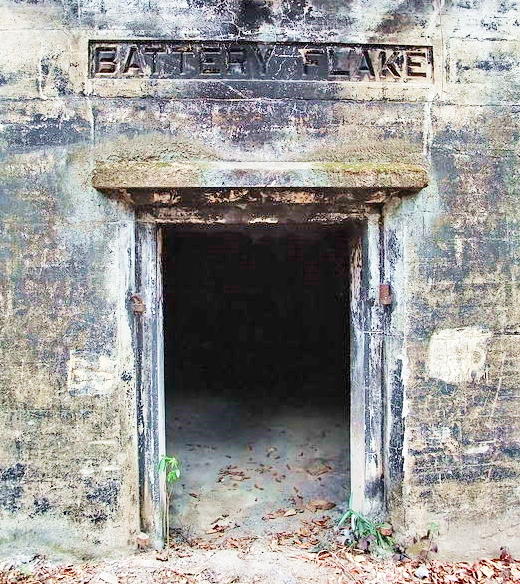
The entrance to the magazines of Battery Flake at Fort Wint, on Grande Island, Philippines.
Photo from the Corregidor Then And Now website
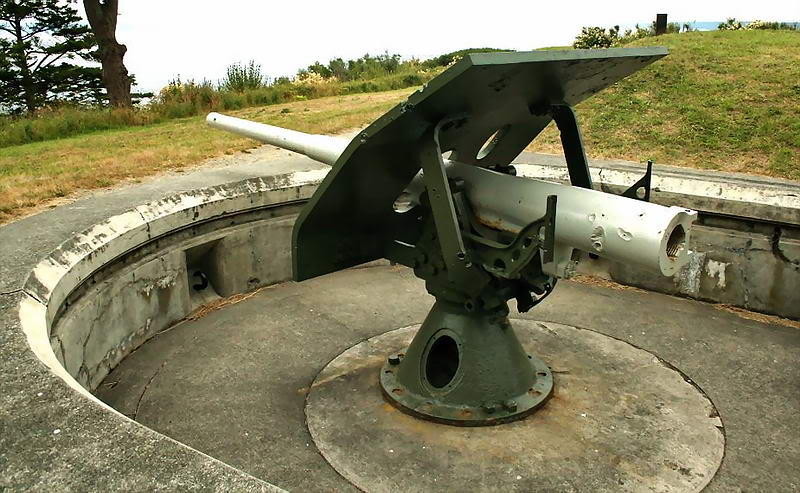
One of the 3 inch guns from Battery Flake, now mounted at Fort Casey, Washington.
Photo from the Corregidor The And Now website
Top photo of 2nd Lieutenant Campbell W. Flake
taken at Fort Reno, Indian Territory 1903.
From the Army and Navy Register (Illustrated supplement)
August 1, 1903
Home | Photos | Battles & History | Current |
Rosters & Reports | Medal of Honor | Killed
in Action |
Personnel Locator | Commanders | Station
List | Campaigns |
Honors | Insignia & Memorabilia | 4-42
Artillery | Taps |
What's New | Editorial | Links |